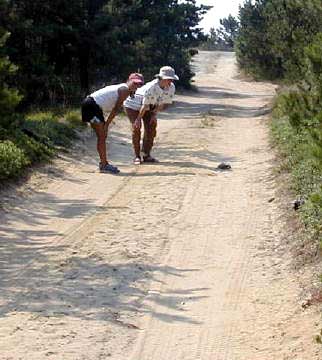Loose Ends — 23 September 2001
 |
 |
As the hatching season begins to tail off out here at the end of the terrapin universe, it affords an opportunity to close out some of the open stories from earlier in the season. The first one began on the morning of 28 June when Adriana and Carol from our Terrapin Field School spotted Turtle 760 as she laid her nest in the middle of Stearns Road (see Terrapin Field Shool Wraps Up — 29 June 2001). You may recall they waved down a large truck heading down the road, rescuing both terrapin and nest. Number 760 had already survived one traumatic encounter with a vehicle when she was run over on 3 July 1999. |
 |
 |
Nest 103 hatched on 15 September with 14 perfect terrapin babies. Another great save for the Field School Class of 2001. |
That same 28 June morning, Terrapin 268 crawled out of the Fox Island marsh to lay Nest 104 in a sandy dune on Indian Neck. Another team from the Field School spotted her and marked the nest for follow-on observation and protection. On 22 September we noticed a surface disturbance under the predator excluder cage, obviously reflecting movement in the egg chamber below. Excavating, we found a broil of activity — seven hatchlings en route to the surface and six more pipped or pipping.

On the afternoon of 2 July, Terrapin 120 laid her nest in the driveway of Tom and Pam Murphy on the top of a steep hill overlooking Lieutenant Island’s Turtle Pass (see Continuity — 2 July 2001). Seventy-six days later on 16 September, we held an impromptu hatching party to check the status of Nest 114. With a couple dozen neighbors to cheer and assist, we discovered 11 hatchlings lined up in the escape tunnel and one viable egg still not pipped. |
 |
 |
Finally, Nest 129 was laid on the evening of 5 July by Terrapin 363. A resident had spotted her nesting in the middle of E Street and waved me down as I patrolled Lieutenant Island (see New Friends and Old — 5 July 2001). Her nesting run had been disturbed by traffic, and she returned to the bay with two eggs still inside her. And, as reported back then, #363 displayed a newly cracked carapace, probably resulting from an encounter with a vehicle during her first nesting run of the year sometime in mid-June. |
 |
 |
|
|  |
 |
A new cottage is being erected within a couple of hundred feet of this nest, and now that the foundation is complete, large trucks have begun to make deliveries of heavy building material. I spotted an 18-wheeler heading toward the site early on 20 September and decided the better part of valor was to excavate the nest before it suffered the same fate of several other roadway nests this summer. I was especially concerned because #363 digs very shallow nests. Last summer I had relocated her nest from F Street because the top egg was protruding from the hole. Whatever the rationale, she’s now the mother of seven more beautiful hatchlings whom I pray will NOT adopt their mother’s habit of digging shallow nests in the middle of dirt roads. But just in case, I know the next generation Paludal Posse will be on hand to assist as needed.
|





